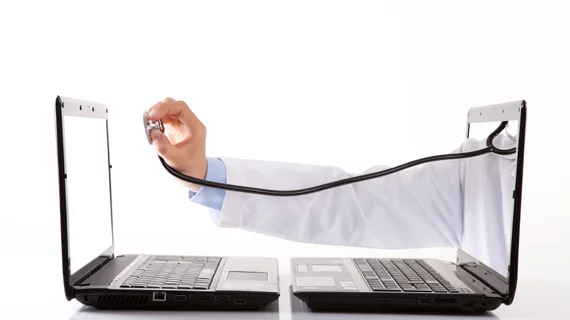Telemonitoring for heart failure linked to 40% drop in mortality at 6 months
Home telemonitoring approaches for heart failure patients are associated with lower odds of death at six months but not beyond that, according to a meta-analysis published in the December issue of Health Affairs.
More than 5.8 million people in the U.S. have heart failure, and that number is expected to reach 8 million by 2030, according to the authors. The condition is estimated to cost the U.S. healthcare system $100 billion per year.
Home telemonitoring (HTM), in which there is an automated process for the transmission of health status data from a patient’s home to a healthcare setting, has been proposed as one solution to reduce hospital readmissions and costs associated with heart failure.
So far, there have been more than 1,200 studies attempting to evaluate the benefit of these interventions, and those analyses have produced conflicting results, noted lead author Renee Pekmezaris, PhD, and colleagues.
In an attempt to fill the evidence gaps on HTM for heart failure, Pekmezaris et al. performed a meta-analysis of 26 randomized controlled trials containing roughly 2,500 patients who received home telemonitoring interventions and a similar number who received normal care.
The researchers found HTM interventions were linked to a 40 percent decrease in all-cause mortality at six months when compared to the control group. However, the mortality reduction of 15 percent at one year was no longer statistically significant.
Likewise, gaps in all-cause and heart failure-specific hospitalizations weren’t significantly different between the two groups at three or six months. However, all-cause emergency department visits were 51 percent higher in the telemonitoring group versus controls at six months.
The authors said the finding of higher ED utilization without an increase in hospital admissions could be due to telemonitoring providing earlier recognition of worsening symptoms that could be treated in the ED but not require a full hospital stay.
“Either way, the prompt exacerbation recognition afforded by HTM will inevitably result in decreased mortality,” they wrote.
As for why telemonitoring was linked to mortality reductions at six months but not one year, Pekmezaris said patients may progressively become less vigilant about monitoring vital signs like weight and blood pressure.
“Whether they are too sick to adhere, or they just don't make it as much of a priority as they did right after their hospitalization, we don't know,” Pekmezaris, a professor in the departments of medicine and population health at Northwell Health in Manhasset, New York, said in a press release. “But, these findings are important because, as scientists and providers, we need to understand when to rely on telemedicine, and how to create a program that most benefits patients."
Because telehealth was one of the services that was expanded in the Bipartisan Budget Act of 2018, the authors expect the implementation of these approaches to expand and said more research will be needed to pin down which interventions are the most useful. They also called for more studies to specifically analyze the duration of telemedicine approaches—and how long they remain effective—because telemonitoring “can be the right intervention given at the wrong time.”
“As HTM transitions to common use, a value framework should be considered,” Pekmezaris et al. wrote. “Specifically, the balance between the cost of HTM implementation and improvements in length and quality of life, decreases in travel time for patients and providers, and increases in provider efficiency must be constantly assessed.”

